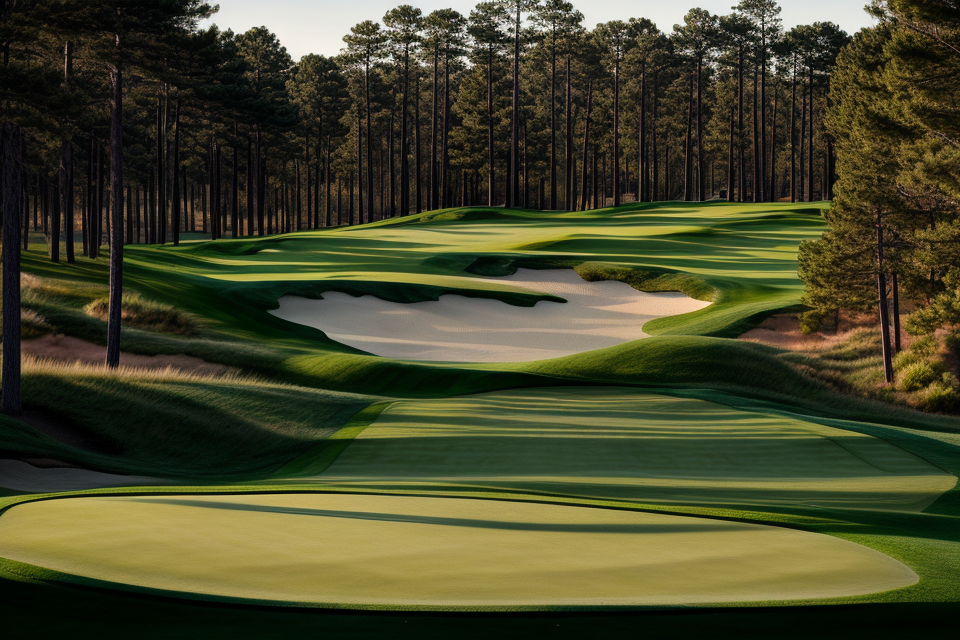Golf architecture refers to the design and construction of golf courses. It involves the creation of unique and challenging layouts that cater to the game of golf. The golf course architect must take into consideration various factors such as the terrain, natural features, and the desired difficulty level of the course. Golf architecture has a significant impact on the game as it shapes the way players interact with the course and influences their strategies. A well-designed golf course can make the game more enjoyable and challenging for players of all skill levels.
Golf architecture refers to the design and construction of golf courses. It encompasses the layout of the land, the placement of hazards and features, and the overall aesthetic of the course. Golf architecture can have a significant impact on the game of golf, as it can affect the difficulty and playability of a course, as well as the enjoyment of the players. A well-designed golf course can challenge players of all skill levels and provide a enjoyable and memorable experience. On the other hand, a poorly designed course can lead to frustration and a lack of enjoyment for players.
What is Golf Architecture?
Design Principles
Golf architecture refers to the design and construction of golf courses. It involves creating a layout that is both challenging and enjoyable for golfers of all skill levels. The design process requires careful consideration of various factors, including landform analysis, routing and shaping, strategic planning, and aesthetic appeal.
Landform Analysis
Landform analysis is the first step in the golf course design process. It involves analyzing the natural features of the land, such as the terrain, soil, and vegetation, to determine the best location for the golf course. This analysis helps the architect to identify the most suitable areas for the tee boxes, fairways, greens, and hazards.
Routing and Shaping
Routing and shaping refer to the layout of the golf course. The architect must decide on the best route for the golfers to follow and how to shape the land to create the desired features. This includes determining the length and direction of the fairways, the placement of hazards, and the design of the greens.
Strategic Planning
Strategic planning involves creating a golf course that is challenging and enjoyable for golfers of all skill levels. The architect must consider the varying abilities of golfers and design the course in such a way that it rewards good play while punishing poor shots. This requires careful consideration of factors such as the distance between tee boxes and the placement of hazards.
Aesthetic Appeal
Aesthetic appeal refers to the visual appearance of the golf course. The architect must design the course in a way that is visually appealing to golfers. This includes the use of landscaping, water features, and other design elements to create an attractive and memorable golfing experience.
Golf Course Architects
Golf course architects are responsible for designing and constructing golf courses. They are experts in the field of golf architecture and have a deep understanding of the design principles and techniques involved in creating a challenging and enjoyable golf course. Some of the most renowned golf course architects include Alister MacKenzie, Donald Ross, Robert Trent Jones Sr., and Tom Doak.
The Impact of Golf Architecture on the Game
Strategy and Variability
Golf architecture plays a significant role in shaping the game of golf by influencing the strategy and variability of the course. Some of the ways in which golf architecture impacts the game are:
- Risk and reward opportunities: Golf courses are designed with strategic risk and reward opportunities that test the skill and judgment of golfers. For example, a narrow fairway may require a player to take a risk and hit a longer shot to reach the green, but it also increases the chance of hitting a hazard or out-of-bounds.
- Green complexes: The design of greens also impacts the strategy and variability of the game. For instance, a large, undulating green may require a player to use different approaches and techniques to hit the ball close to the hole.
- Fairway widths: The width of fairways can also affect the strategy of the game. A wide fairway may allow players to take a more aggressive approach, while a narrow fairway may require more precision and accuracy.
Player Experience
Golf architecture also has an impact on the player experience. Some of the ways in which golf architecture affects the player experience are:
- Visual appeal: Golf courses are designed to be visually appealing, with aesthetically pleasing landscapes and natural features. The design of the course can impact the overall enjoyment of the game for players.
- Walkability: The layout and design of the course can also impact the walkability of the course. A well-designed golf course should be easy to walk, with ample opportunities for players to take in the scenery and enjoy the natural surroundings.
- Interaction with natural environment: Golf courses are often built in natural environments, such as forests, wetlands, and deserts. The design of the course should incorporate and preserve the natural environment, allowing players to interact with and appreciate the unique features of the landscape.
Evolution of Golf Course Design
Golf course design has evolved over time, with modern trends focusing on sustainability and the use of technology. Some of the ways in which golf course design has evolved include:
- Modern trends: Golf course design has evolved to incorporate modern trends, such as the use of more environmentally friendly materials and practices. Designers are also using technology to create more challenging and interesting courses.
- Sustainability: Sustainability is a key consideration in modern golf course design. Designers are working to create courses that are environmentally friendly and have a minimal impact on the natural environment.
- Technology: Technology is also playing a bigger role in golf course design. Designers are using advanced software and simulation tools to create more accurate and detailed designs, and to test different course configurations.
The Importance of Golf Architecture
Economic Impact
Golf architecture plays a significant role in the economy of a region or country. The construction and maintenance of golf courses can create jobs for local residents, which in turn contributes to the growth of the economy. Golf courses can also attract tourists from all over the world, generating revenue for the local economy through tourism. In addition, the development of golf courses can lead to real estate development, which can increase property values and create more job opportunities.
Cultural Significance
Golf courses are not just places for people to play golf; they are also cultural landmarks that have historical and social significance. Many golf courses are designed to preserve the natural beauty of the land, and the architecture of the course reflects this commitment to preservation. Golf courses also provide a space for social interaction, where people can connect with others who share a passion for the game. The preservation of golf courses is essential to maintaining the cultural heritage of the game and ensuring that future generations can continue to enjoy the sport.
The Future of Golf Architecture
Technology and Innovation
Golf architecture has always been at the forefront of technological advancements, and this trend is set to continue in the future. One of the most significant areas of innovation is the use of golf simulators. These cutting-edge devices allow golfers to practice their swing and play virtual rounds of golf, regardless of weather conditions or the availability of a physical course. Additionally, green construction materials are becoming increasingly popular, as architects strive to create sustainable and environmentally friendly golf courses. 3D printing is also being explored as a means of creating intricate and complex golf course designs.
Sustainability and Environmentalism
Sustainability and environmentalism are also key factors in the future of golf architecture. Many golf courses are now turning to renewable energy sources, such as solar and wind power, to reduce their carbon footprint and minimize their impact on the environment. Water conservation is another critical area of focus, with architects and course managers implementing innovative solutions to reduce water usage and protect local ecosystems. Furthermore, many golf courses are now incorporating wildlife habitats into their designs, creating a more diverse and vibrant environment for both golfers and local wildlife to enjoy.
The Role of Golf Architecture in Enhancing the Game
Golf architecture plays a crucial role in enhancing the game by ensuring that the balance between challenge and enjoyment is maintained. Courses that are too difficult can lead to frustration and a lack of enjoyment, while those that are too easy can become monotonous and uninteresting. Golf architects must carefully design courses that cater to a wide range of skill levels, providing a challenge for experienced players while still being accessible to beginners.
Another key aspect of golf architecture is creating memorable experiences for golfers. This includes not only the design of the course itself but also the overall atmosphere and ambiance. Well-designed courses can create a sense of excitement and anticipation, leading to a more enjoyable and memorable round of golf. In addition, incorporating unique features such as water hazards, bunkers, and natural terrain can help to make a course stand out and create a lasting impression on golfers.
Maintaining tradition while embracing change is another important role of golf architecture. While the game of golf has a rich history and tradition, it is also important to evolve and adapt to changing times. Golf architects must balance the need to preserve the history and heritage of the game with the need to incorporate modern design principles and technologies. This can involve using sustainable materials and construction methods, incorporating new materials and technologies, and creating courses that are more accessible to a wider range of players.
In summary, golf architecture plays a critical role in enhancing the game by balancing challenge and enjoyment, creating memorable experiences, and maintaining tradition while embracing change. Golf architects must carefully design courses that cater to a wide range of skill levels, incorporate unique features and natural terrain, and use sustainable materials and construction methods. By doing so, they can help to ensure that the game of golf continues to thrive and evolve for years to come.
FAQs
1. What is golf architecture?
Golf architecture refers to the design and construction of golf courses. It involves creating a layout that is both aesthetically pleasing and challenging for golfers of all skill levels. The design of a golf course can have a significant impact on the way the game is played, and skilled golf architects take into account factors such as topography, climate, and player experience when creating a course.
2. How does golf architecture impact the game?
Golf architecture plays a crucial role in the game of golf as it determines the layout and challenges of a course. A well-designed golf course can test a golfer’s skills, while also providing an enjoyable and visually appealing experience. Golf architecture can impact the game by creating different strategies for players to use, such as risk and reward opportunities, and by using the natural landscape to enhance the challenge of the course. Additionally, the design of a golf course can affect the pace of play, which can impact the overall experience of the game.
3. What are some key elements of golf architecture?
Some key elements of golf architecture include the design of the fairways, greens, and hazards. Golf architects must take into account the natural landscape and create a layout that maximizes the use of the land while also providing a challenging and enjoyable experience for golfers. Other key elements include the placement of bunkers and water hazards, the design of the green complexes, and the overall routing of the course.
4. What is the history of golf architecture?
The history of golf architecture dates back to the early days of golf, with the first formal golf courses being built in Scotland in the 18th century. Since then, golf architecture has evolved to include a variety of styles and approaches, with influential architects such as Old Tom Morris and Donald Ross making significant contributions to the field. Today, golf architecture continues to evolve, with modern architects using technology and innovative design techniques to create challenging and visually appealing courses.
5. How does the design of a golf course impact the game?
The design of a golf course can have a significant impact on the game of golf. A well-designed course can test a golfer’s skills, while also providing an enjoyable and visually appealing experience. The placement of hazards, the design of the green complexes, and the overall routing of the course can all impact the way the game is played, and skilled golf architects take into account factors such as topography, climate, and player experience when creating a course. Additionally, the design of a golf course can affect the pace of play, which can impact the overall experience of the game.









